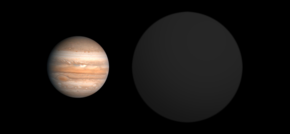 Size comparison of WASP-12b (right) with Jupiter | |
| Discovery | |
|---|---|
| Discovered by | Cameron et al. (SuperWASP) |
| Discovery site | SAAO |
| Discovery date | April 2008[1] |
| Transit | |
| Orbital characteristics | |
| 0.0234+0.00056 −0.00050 AU | |
| Eccentricity | 0.049 ± 0.015 |
| 1.091423±0.000003 d | |
| Inclination | 83.37°+0.72° −0.64° |
| −74°+13° −10° | |
| Star | WASP-12 |
| Physical characteristics | |
| 1.900+0.057 −0.055,[2] RJ | |
| Mass | 1.47+0.076 −0.069[2] MJ |
Mean density | 0.266 g/cm3[2] |
| 3.004±0.015 g[2] | |
| Temperature | 3128+64 −68 K (2885+64 −68 °C, 5225+147 −155 °F)[3] |
WASP-12b is a hot Jupiter[4] (a class of extrasolar planets) orbiting the star WASP-12, discovered in April of 2008, by the SuperWASP planetary transit survey.[5][1] The planet takes only a little over one Earth day to orbit its star, in contrast to about 365.25 days for the Earth to orbit the Sun. Its distance from the star (approximately 3.5 million kilometers [2.2 million miles; 0.023 astronomical units]) is only the Earth's distance from the Sun, with an eccentricity the same as Jupiter's. Consequently, it has one of the lowest densities for exoplanets ("inflated" by the flux of energy from the star). On December 3, 2013, scientists working with the Hubble Space Telescope (HST) reported detecting water in the atmosphere of the exoplanet.[6][7] In July 2014, NASA announced finding very dry atmospheres on three exoplanets (HD 189733b, HD 209458b, WASP-12b) orbiting sun-like stars.[8]
In September 2017, researchers working on the HST announced that WASP-12b reflects just 6% of the light that shines on its surface. As a result, the exoplanet has been described as "black as asphalt" and as "pitch black."[9]
- ^ a b Cite error: The named reference
NBC newswas invoked but never defined (see the help page). - ^ a b c d Collins, Karen A; Kielkopf, John F; Stassun, Keivan G (2017). "Transit Timing Variation Measurements of WASP-12b and Qatar-1b: No Evidence for Additional Planets". The Astronomical Journal. 153 (2): 78. arXiv:1512.00464. Bibcode:2017AJ....153...78C. doi:10.3847/1538-3881/153/2/78. S2CID 55191644.
- ^ Owens, Niall; De Mooij, E J W.; Watson, C. A.; Hooton, M. J. (2021), "Phase curve and variability analysis of WASP-12b using TESS photometry", Monthly Notices of the Royal Astronomical Society: Letters, 503: L38–L46, arXiv:2102.00052, doi:10.1093/mnrasl/slab014
- ^ Starr, Michelle (April 23, 2018). "Astronomers Just Found a 'Hot Jupiter' So Dark, It Absorbs Nearly 99% of Light". ScienceAlert.
- ^ "WASP Planets". SuperWASP. December 5, 2013. Retrieved January 26, 2016.
- ^ Staff (December 3, 2013). "Hubble Traces Subtle Signals of Water on Hazy Worlds". NASA. Retrieved December 4, 2013.
- ^ Mandell, Avi M.; Haynes, Korey; Sinukoff, Evan; Madhusudhan, Nikku; Burrows, Adam; Deming, Drake (December 3, 2013). "Exoplanet Transit Spectroscopy Using WFC3: WASP-12 b, WASP-17 b, and WASP-19 b". Astrophysical Journal. 779 (2): 128. arXiv:1310.2949. Bibcode:2013ApJ...779..128M. doi:10.1088/0004-637X/779/2/128. S2CID 52997396.
- ^ Harrington, J.D.; Villard, Ray (July 24, 2014). "RELEASE 14-197 - Hubble Finds Three Surprisingly Dry Exoplanets". NASA. Retrieved July 25, 2014.
- ^ Wall, Mike (September 18, 2017). "The hellish world WASP-12b is darker than fresh asphalt in visible light, but glows red-hot in infrared". Scientific American. Retrieved September 19, 2017.
